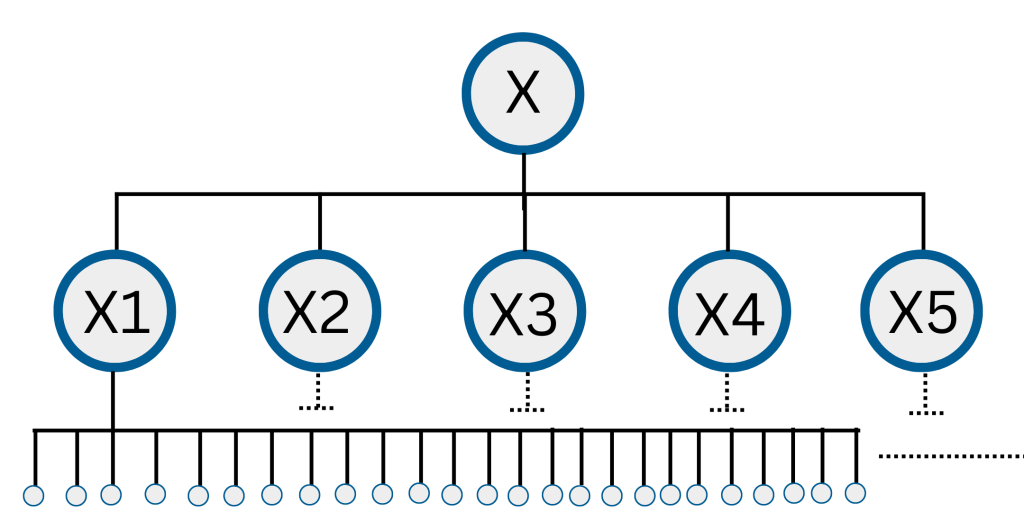

Matrix MLM plan, or forced matrix plan, has a predetermined precise and clear organizational structure. The clarity of the depth and width makes the plan unique from the other compensation plans.
The matrix plan process is easy to manage and operate and helps create teambuilding in the organization. “unlimited opportunity to a limited income position,” Matrix plan works in this motto. It can be beneficial from a direct selling company’s perspective.
The Matrix MLM Plan, also called a Forced Matrix, works like a structured grid with set limits on how wide and deep it can grow. Think of it like a family tree with specific rules. It starts with just two spots on the first level. As more people join, they fill in the available spaces, kind of like a puzzle. If a spot is already taken, the new member goes to the next open spot further down the line.
This system encourages people to focus on building their team below them because they can only sponsor a limited number of people directly. It’s like a pyramid, but with strict rules about how many people can be on each level. This makes it different from other MLM plans where you can build your team as wide as you want.
Matrix compensation plan appears as a pyramid structure with fixed width and depth and is represented by the formulae Width*Depth. In the matrix plan, the number of distributors you can sponsor in the first level is fixed or restricted. The structure of the matrix plan limits the expansion in width and encourages to sponsor of more people in the downline to increase the depth.

In the case of a 5*2 matrix tree, 5 is the width of the tree, and 2 is the depth of the tree. In the matrix plan, the width is limited; therefore, once the five positions in the first level are completed, the members that come after that are placed in the next level. According to the matrix 5*2 second level consist of 25 members and third level consist of 125 members . As this goes on, there will be one member as the sponsor and five members in the first and 25 members in the second level . By this, the 5*2 matrix cycle is completed. This process is carried on. Due to the restriction in width, the distributors are forced to add the members to the downlines from the 2nd level’s wards. This process is why the Matrix MLM plan also gets the name Forced matrix plan.
Imagine a grid with 3 columns and 2 rows. This is a simple way to visualize a 3×2 matrix plan in multi-level marketing (MLM).
Here’s how it works:
- Limited Space: You can only add a maximum of 3 distributors in the first row. Once those spots are filled, new members “spill over” to the next row.
- Forced Growth: This “spillover” effect encourages distributors to build their teams deeper within the structure, as there’s no room to expand horizontally beyond the initial 3 spots. This is why it’s often called a “forced matrix” plan.
- Structured Growth: The matrix plan creates a defined structure for team building, with a clear limit on how many direct members each distributor can have.
- Company-Specific Rules: Different MLM companies may have specific rules for how “spillover” occurs and how bonuses are awarded within the matrix structure.
In essence, the matrix plan provides a framework for team building in MLM, encouraging both breadth and depth in developing a successful network.
The filling of distributors from the 2nd level and down is known as Spillover. In the process of Spillover, once the first frontline positions are filled, the members fill up the next positions under the first level based on the available positions. Multiple spilling preferences used in the Matrix plans are:
You continue this pattern. Your seventh member (Person G) would go under Person A again, your eighth (Person H) under Person B, and so on. This creates a balanced, organized structure, much like a matrix in mathematics, hence the name ‘matrix tree’.
Just like building blocks, you can combine the matrix plan with other compensation plans in MLM. This flexibility allows for creating unique and customized reward systems. For example, you could integrate the matrix plan with a unilevel plan, creating a hybrid approach. Furthermore, the matrix plan can be easily adapted to incorporate other elements, such as e-learning platforms or even investment-based programs, making it a versatile tool for modern MLM companies.
1. Spillover Effect
The extra members you’ve recruited are automatically placed under other members of your team who still have open spots. This not only benefits those members by expanding their own teams, but it also accelerates the overall growth of your network. It’s like a domino effect, where new recruits contribute to the success of the entire team, not just the original recruiter.
2. Team Collaboration
In this system, each team member is assigned a specific area of responsibility, often visualized as a ‘matrix.’ These matrices have a limited size, encouraging everyone to work together to ensure everyone on the team succeeds. This collaborative approach fosters a supportive and encouraging environment where team members actively help each other achieve their goals. By working together and sharing resources, the entire team benefits, leading to greater overall success.
3. Fast Cycling
In many multi-level marketing (MLM) programs, a ‘cycle’ refers to the completion of a specific sales or recruitment goal, often within a designated team structure. When a member successfully completes their assigned cycle and receives a commission, it’s known as ‘cycling.’ Compared to some broader MLM structures, binary systems often allow for faster cycling. This means that members can potentially earn commissions more frequently, leading to quicker income generation.
2. Spillover Dependency
One potential downside of relying heavily on ‘spillover’ in a multi-level marketing (MLM) system is that it can breed complacency. When distributors primarily depend on new members joining their team automatically through the efforts of others above them in the hierarchy, they may become less motivated to actively recruit themselves. This can be risky. If the expected ‘spillover’ doesn’t materialize as anticipated, it can significantly slow down their team’s growth and ultimately limit their earning potential.
3. Balancing Placement
To make the most of their earnings, network marketers need to strategically place new recruits within the company’s organizational structure. This is crucial because an unbalanced team can lead to missed income opportunities. Imagine a team where one side is booming with activity while the other side remains stagnant – it’s like trying to balance a seesaw with all the weight on one end. To avoid this, effective leadership and careful planning are essential. By strategically guiding new members and ensuring balanced growth across their team, network marketers can maximize their earning potential and build a sustainable and successful business.